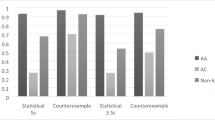Abstract
Rationale
Benzodiazepines slow reasoning performance, but it is still unknown which phase of reasoning is affected and whether this effect is present for different types of relations between entities in reasoning problems.
Objectives
We investigated which phases of deductive reasoning are affected by lorazepam and whether this effect varies according to the type of relations in deductive reasoning problems.
Methods
This was a double-blind, crossover design study of acute oral doses of lorazepam (2 mg) and placebo, using young healthy volunteers. We focused on response delay of three separable phases of deductive reasoning and matched working memory tasks (that involved only maintenance of information) the premise processing phase, the premise integration phase, and the validation phase, in which reasoners decide whether a conclusion logically follows from the premises (reasoning task) or is identical to one of the premises (maintenance task). Type of relations in the premises was also manipulated. We employed material that was difficult to envisage visually and visuospatially (“subiconic”) and material easy to envisage visually or visuospatially.
Results
Lorazepam slowed response as memory load increased, irrespective of type of relations. It also specifically slowed validation in reasoning problems with visual relations, an effect that disappeared after subtraction of maintenance scores, and increased validation time in problems with subiconic relations, which remained after this subtraction.
Conclusion
Acute lorazepam administration affected reasoning in two ways: it slowed processing nonspecifically when working memory demands increased and augmented validation time depending on the difficulty in generating and/or manipulating mental representations by the central executive.



Similar content being viewed by others
References
Allen D, Curran HV, Lader M (1993) The effects of single doses of CL 284,846, lorazepam, and placebo on psychomotor and memory function in normal male volunteers. Eur J Clin Pharmacol 45:313–320
Ameer B, Greenblatt DJ (1981) Lorazepam: a review of its clinical pharmacological properties and therapeutic uses. Drugs 21:161–200
Baddeley A (1968) A three minute reasoning test based on grammatical transformation. Psychon Sci 10:341–342
Baddeley A (2000) The episodic buffer: a new component of working memory? Trends Cogn Sci 4:417–423
Carroll JB (1993) Human cognitive abilities. Cambridge University Press, Cambridge
Casasanto D (2003) Hemispheric specialization in prefrontal cortex: effects of verbalizability, imageability and meaning. J Neurolinguist 16:361–382
Copeland D, Radvansky G (2004) Working memory and syllogistic reasoning. Q J Exp Psychol A 57:1437–1457
Coull JT, Middleton HC, Robbins TW, Sahakian BJ (1995) Contrasting effects of clonidine and diazepam on tests of working memory and planning. Psychopharmacology 120:311–321
Coull JT, Frith CD, Dolan RJ (1999) Dissociating neuromodulatory effects of diazepam on episodic memory encoding and executive function. Psychopharmacology 145:213–222
Curran VH (2000) Psychopharmacological perspectives on memory. In: Tulving E, Craik FIM (eds) The handbook of memory. Oxford University Press, Oxford, pp 539–556
Curran HV, Schifanno F, Lader M (1991) Models of memory dysfunction? A comparison of the effects of scopolamine and lorazepam on memory, psychomotor performance and mood. Psychopharmacology 103:83–90
Curran HV, Gorenstein C, Lader M (1993) Comparative amnesic and sedative effects of lorazepam and oxazepam in healthy volunteers. J Psychopharmacol 7:249–256
Drummond SP, Brown GG, Salamat JS (2003) Brain regions involved in simple and complex grammatical transformations. Neuroreport 14:1117–1122
Duka T, Stephens DN, Krause W, Dorow R (1987) Human studies on the benzodiazepine receptor antagonist beta-carboline ZK 93,426: preliminary observations on psychotropic activity. Psychopharmacology 93:421–427
Duka T, Goerke D, Dorow R, Holler L, Fichte K (1988) Human studies on the benzodiazepine receptor antagonist beta-carboline ZK 93 426: antagonism of lormetazepam’s psychotropic effects. Psychopharmacology 95:463–471
Fangmeier T, Knauff M, Ruff CC, Sloutsky V (2006) MRI evidence for a three-stage model of deductive reasoning. J Cogn Neurosci 18:320–334
Fernandes F (1953) Dicionário de sinônimos e antônimos da língua portuguesa, 7th edn. Editora Globo, Rio de Janeiro
Goel V (2005) Cognitive neuroscience of deductive reasoning. In: Holyoak K, Morrison R (eds) Cambridge handbook of thinking and reasoning. Cambridge University Press, Cambridge
Goel V, Dolan RJ (2001) Functional neuroanatomy of three-term relational reasoning. Neuropsychologia 39:901–909
Gorenstein C, Andrade L (1996) Validation of a Portuguese version of the Beck Depression Inventory and the State-Trait Anxiety Inventory in Brazilian subjects. Braz J Med Biol Res 29:453–457
Johnson-Laird PN (2005) Mental models and thought. In: Holyoak K, Morrison R (eds) The Cambridge handbook of thinking and reasoning. Cambridge University Press, Los Angeles, pp. 185–208
Knauff M, Johnson-Laird PN (2000) Visual and spatial representations in spatial reasoning. In: Gleitman LR, Joshi AK (eds) Proceedings of the twenty-second annual conference of the cognitive science society. Erlbaum, Mahwah, pp 759–765
Knauff M, Johnson-Laird PN (2002) Visual imagery can impede reasoning. Mem Cognit 30:363–371
Knauff M, May E (2006) Mental imagery, reasoning, and blindness. Q J Exp Psychol 59:161–177
Knauff M, Fangmeier T, Ruff CC, Johnson-Laird PN (2003) Reasoning, models, and images: behavioral measures and cortical activity. J Cogn Neurosci 15:559–573
Markovits H, Doylon C, Simoneasu M (2001) Individual differences in working memory and conditional reasoning with concrete and abstract content. Think Reasoning 8:97–107
Mintzer MZ, Griffiths RR (2003) Lorazepam and scopolamine: A single-dose comparison of effects on human memory and attentional processes. Exp Clin Psychopharmacol 11:56–72
Mintzer MZ, Griffiths RR (2007) A triazolam/amphetamine dose–effect interaction study: dissociation of effects on memory versus arousal. Psychopharmacology 192:425–440 DOI 10.1007/s00213-007-0726-y
Mintzer MZ, Kuwabara H, Alexander M, Brasic JR, Ye W, Ernst M, Griffiths RR, Wong DF (2006) Dose effects of triazolam on brain activity during episodic memory encoding: a PET study. Psychopharmacology 188:445–461
Miyake A, Friedman NP, Rettinger DA, Shah P, Hegarty M (2001) How are visuospatial working memory, executive functioning, and spatial abilities related? A latent-variable analysis. J Exp Psychol Gen 130:621–640
Oberauer K, Weidenfeld A, Hornig R (2006) Working memory capacity and the construction of spatial mental models in comprehension and deductive reasoning. Q J Exp Psychol 59:426–447
Pearson DG, Logie RH, Gilhooly KJ (1999) Verbal representations and spatial manipulation during mental synthesis. Eur J Exp Psychol 11:295–314
Pompéia S, Bueno OFA, Tufik S (2003) Lorazepam should no longer be used as a prototypical benzodiazepine. Psychopharmacology 169:211–212
Pompéia S, Manzano GM, Tufik S, Bueno OFA (2005) What makes lorazepam different from other benzodiazepines? J Physiol 15:315–323
Rader AW, Sloutsky VM (2002) Processing of logically valid and logically invalid conditional inferences in discourse comprehension. J Exp Psychol Learn Mem Cogn 28:59–68
Reder LM, Proctor I, Anderson JR, Gyulai F, Quinlan JJ, Oates JM (2006) Midazolam does not inhibit association formation, just its storage and strengthening. Psychopharmacology 188:462–471
Repovs G, Baddeley A (2006) The multi-component model of working memory: explorations in experimental cognitive psychology. Neuroscience 139:5–21
Ruff CC, Knauf M, Fangmeier T, Sprer J (2003) Reasoning and working memory: common and sitinct neuronal processes. Neuropsychologia 41:1241–1253
Rusted JM, Eaton-Williams P, Warburton DM (1991) A comparison of the effects of scopolamine and diazepam on working memory. Psychopharmacology 105:442–445
Sardinha TB (2003) The Bank of Portuguese. DIRECT Papers 50. LAEL, PUCSP and AELSU, University of Liverpool. http://www2.lael.pucsp.br/corpora/bp/index.htm
Sardinha TB (2004) Lingüística de Corpus. Manole, São Paulo
Vandierendonck A, Dierckx V, De Vooght G (2004) Mental model construction in linear reasoning: evidence for the construction of initial annotated models. Q J Exp Psychol A 57:1369–1391
Vecchi T, Girelli L (1998) Gender differences in visuospatial processing: the importance of distinguishing between passive storage and active manipulation. Acta Psychol 99:1–16
Vermeeren A, Danjou PE, O’Hanlon JF (1998) Residual effects of evening and middle-of-the-night administration of zaleplon 10 and 20 mg on memory and actual driving performance. Hum Psychopharmacol 13:S98–S107
Wesensten NJ, Balkin TJ, Belenky GL (1996) Effects of daytime administration of zolpidem and triazolam on performance. Aviat Space Environ Med 67:115–120
Acknowledgements
Fundacao de Amparo a Pesquisa do Estado de Sao Paulo (grant no. 03/00046-9; funding project no. 03/08025-0) and Associacao Fundo de Incentivo a Psicofarmacologia, for financial support. The experiment reported here complies with current laws in the country where it was performed (Brazil).
Author information
Authors and Affiliations
Corresponding author
Rights and permissions
About this article
Cite this article
Pompéia, S., Manzano, G.M., Pradella-Hallinan, M. et al. Effects of lorazepam on deductive reasoning. Psychopharmacology 194, 527–536 (2007). https://doi.org/10.1007/s00213-007-0864-2
Received:
Accepted:
Published:
Issue Date:
DOI: https://doi.org/10.1007/s00213-007-0864-2




